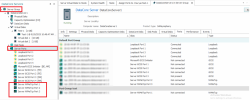NVMe over Fabrics (NVMeoF) Specific
Explore this Page
- Overview
- Discover NVMeoF in DataCore Management Console
- Prerequisites
- Enabling NVMeoF in DataCore Server Group
Overview
Starting with SANsymphony PSP21, NVMe over Fabrics (NVMeoF) is supported, enabling high-performance, low-latency storage connectivity via NVMe/TCP (NVMe carried over standard Transmission Control Protocol/IP networks) and NVMe/FC (NVMe over Fibre Channel) protocols.
This feature allows you to enable NVMeoF in SANsymphony, create NVMe namespaces, and serve them to Linux and Proxmox hosts using NVMe/TCP or NVMe/FC.
When NVMeoF is enabled for a virtual disk, all host access to that disk, including derived objects such as snapshots and rollbacks, is served over the NVMeoF protocol. This ensures consistent high-performance and low-latency access to data from the host perspective, while SANsymphony continues to provide advanced storage services such as mirroring, replication, and recovery.
Discover NVMeoF in DataCore Management Console
After upgrading or installing DataCore SANsymphony servers to PSP21 or higher, verify that:
The new Server NVMeTcp Ports are visible in the DataCore Management Console > Server Group > Server Ports.
NVMe/Fibre Channel (NVMe/FC) connectivity for NVMeoF is available only after selecting the NVMeoF Enabled checkbox in the Server Group settings and then selecting the NVMeoF Front-end Capability checkbox on the corresponding Fibre Channel ports. Refer to Modifying Fibre Channel Port Settings for more information.
It is recommended to use NVMeoF with Proxmox hosts running Proxmox VE version 8.
Prerequisites
- Requires SANsymphony PSP21 or higher.
- Emulex HBA is required only when using NVMe/FC. The NVMeoF capability is supported only on Emulex Fibre Channel ports.
- Ensure that the appropriate licenses (CSP, EN, and BR) are activated for NVMeoF features to function correctly.
Enabling NVMeoF in DataCore Server Group
- Go to Server Group and select the Settings tab
- Under Advanced Settings, select the NVMeoF Enabled checkbox to enable NVMeoF.
- Once NVMeoF is enabled in the Server Group, you can:
- Configure NVMe Server Ports. Refer to the Modifying NVMeTCP Port Settings section for details on NVMeTCP Server Port roles.
- Create an NVMe Namespace Virtual Disk. Refer to the Creating Virtual Disks section for information on enabling NVMe in Virtual Disks.
- Serve the Virtual Disk over NVMeoF.
- Mirror and Replication Paths: All mirror and replication traffic will continue to use SCSI, even if the Virtual Disk is served over NVMeoF. This ensures compatibility with existing replication and disaster recovery workflows
- NVMeoF feature does not support loopback mappings. Virtual Disks cannot be accessed over NVMeoF from the same server that hosts them.
- The 4 KiB sector size is not supported for virtual disks when using the NVMeoF feature. Do not select 4 KiB in the Sector size field for NVMeoF virtual disks.
- Refer to the General Network Adapter Settings recommendations in DataCore SANsymphony – iSCSI Network and Best Practices (formerly known as FAQ 1691 and 1626). These settings are also applicable to NVMeTCP configurations.
Connecting NVMeoF Initiators
To connect NVMeoF initiators and discover virtual disks in Proxmox environments, refer to the Proxmox Host Configuration Guide for instructions on enabling NVMeTCP targets, configuring multipath, and connecting virtual disks.
Learn More

